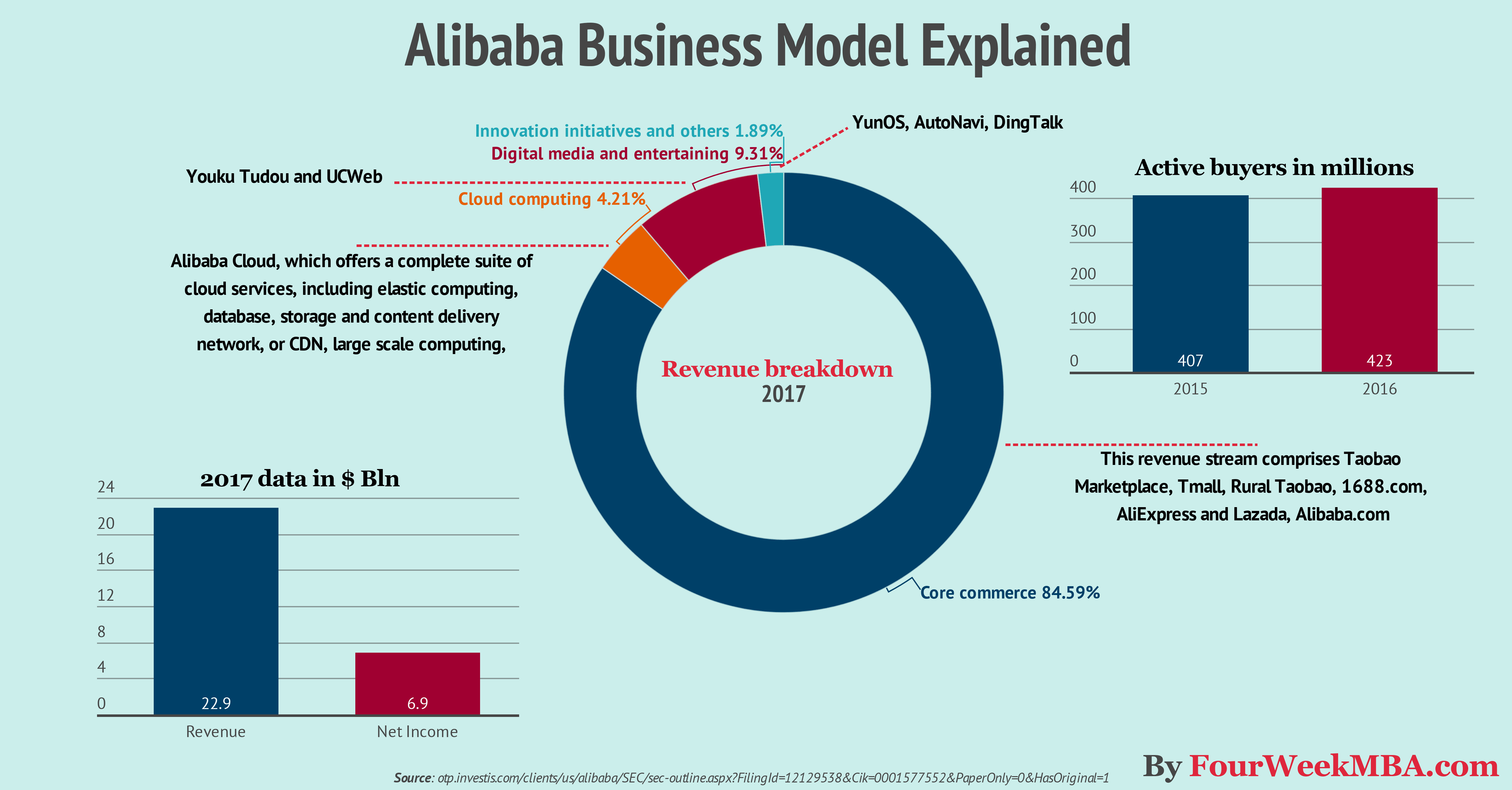| Not logged in : Login |
About: Quick Snapshot of Alibaba Business Model Goto Sponge NotDistinct Permalink

Alibaba is China's biggest online commerce company. Founded on April 4, 1999, Hangzhou, China by Jack Ma. Alibaba is the world's sixth-largest internet company by revenue according to Wikipedia. Alibaba business model looks a lot like the Amazon Business Model. As specified on their annual report: We generate most of our revenue from our core commerce segment. We also earn revenue from services associated with our cloud computing segment, digital media and entertainment segment as well as innovation initiatives and others segment. A substantial majority of our revenue is attributable to our businesses in China. See What Is a Business Model? 30 Successful Types of Business Models You Need to Know Alibaba short background story Alibaba was founded on Jun 1, 1999, by Eddie Wu, Jack Ma. Today they are respectively Senior Vice President and Executive Chairman. With over eight billion dollars raised since 1999. According to Crunchbase, Alibaba has started an acquisition campaign starting in 2010 that saw the acquisition of brands like: Daraz.pk Ejoy Technology Damai.cn Wandoujia AGTech Holdings South China Morning Post Youku Yueke Software AdChina UCWeb AutoNavi Kanbox Xiami Music Network Umeng Vendio Today Alibaba represents a platform that served more than four hundred million people in 2016. Alibaba monetization model As reported on Alibaba annual report: We derive revenue from our four business segments: core commerce, cloud computing, digital media and entertainment, and innovation initiatives and others. We derive most of our revenue from our core commerce segment, which accounted for 85% of our total revenue in fiscal year 2017, while cloud computing, digital media and entertainment, and innovation initiatives and others contributed 4%, 9% and 2%, respectively. We derive a substantial majority of our core commerce revenue from online marketing services. The revenue model of our Core commerce China commerce retail business primarily includes Taobao Marketplace, Tmall, Rural Taobao and commerce technologies and services. China commerce wholesale business includes 1688.com. International commerce retail business includes AliExpress and Lazada. International commerce wholesale business includes Alibaba.com. Alibaba.com Launched in 1999, Alibaba.com is the leading platform for global wholesale trade with millions of buyers and suppliers around the world. AliExpress Launched in 2010, AliExpress.com is an online retail service made up of small businesses in China and elsewhere, such as Singapore, offering products to international online buyers Other platforms Other platforms such as Taobao, 1688.com, and Lazada are part of the Alibaba network. Cloud computing The cloud computing segment is comprised of Alibaba Cloud, which offers a complete suite of cloud services. Digital media and entertainment It primarily includes Youku Tudou and UCWeb. Innovation initiatives and others It includes businesses such as YunOS, AutoNavi, DingTalk. Cost of revenues The principal components of our cost of revenue include: content acquisition costs paid to third parties for online media properties; logistics costs relating to fulfillment services provided to us by affiliate Cainiao Network, primarily related to Tmall Supermarket; traffic acquisition costs paid to third-party marketing affiliates either at a fixed price or on a revenue sharing basis; payment processing fees paid to Alipay or other financial institutions; the cost of inventory; expenses associated with the operation of websites, such as bandwidth and co-location fees, and depreciation and maintenance expenses for our computers, servers, call centers and other equipment; salary, bonuses, benefits and share-based compensation expense; rebates and subsidies mainly relating to our new business initiatives; business taxes and related surcharges; and allowance for doubtful accounts about the microloans and VAT receivables. Alibaba business model infographic Handpicked related articles: What Is a Business Model? 30 Successful Types of Business Models You Need to Know What Is a Business Model Canvas? Business Model Canvas Explained The Power of Google Business Model in a Nutshell How Does Google Make Money? It’s Not Just Advertising! Ok Google, Are You In Search Of A Business Model For Voice? The Future of Google: The Curse of Engineers Become Advertisers When The AI Meets Users’ Intent, Google Takes A Cut On Every Sale On Earth How Does DuckDuckGo Make Money? DuckDuckGo Business Model Explained Who Owns Google? Under The Hood Of The Tech Giant That Conquered The Web The Google of China: Baidu Business Model In A Nutshell How Does Twitter Make Money? Twitter Business Model In A Nutshell How Amazon Makes Money: Amazon Business Model in a Nutshell How Does Netflix Make Money? Netflix Business Model Explained �
| Attributes | Values |
|---|---|
| type | |
| label |
|
| label |
|
| Relation | |
| Description |
|
| depiction | |
| name |
|
| url |
Alternative Linked Data Documents: PivotViewer | iSPARQL | ODE Content Formats:
![[cxml]](/fct/images/cxml_doc.png)
![[csv]](/fct/images/csv_doc.png) RDF
RDF
![[text]](/fct/images/ntriples_doc.png)
![[turtle]](/fct/images/n3turtle_doc.png)
![[ld+json]](/fct/images/jsonld_doc.png)
![[rdf+json]](/fct/images/json_doc.png)
![[rdf+xml]](/fct/images/xml_doc.png) ODATA
ODATA
![[atom+xml]](/fct/images/atom_doc.png)
![[odata+json]](/fct/images/json_doc.png) Microdata
Microdata
![[microdata+json]](/fct/images/json_doc.png)
![[html]](/fct/images/html_doc.png) About
About


![[RDF Data]](/fct/images/sw-rdf-blue.png)
OpenLink Virtuoso version 08.03.3331 as of May 21 2024, on Linux (x86_64-generic-linux-glibc25), Single-Server Edition (7 GB total memory, 6 GB memory in use)
Data on this page belongs to its respective rights holders.
Virtuoso Faceted Browser Copyright © 2009-2024 OpenLink Software


